Got Ants? We’ve Got Solutions!
Whether they’re marching through your kitchen, tunneling through wood, or piling up dirt in your driveway, ants can be a real nuisance—but you don’t have to deal with them alone! From tiny sugar-seekers to wood-destroying invaders, we handle all types of ants with expert solutions tailored to your needs.
Identify. Treat. Prevent. We do it all!
Contact our amazing team today and reclaim your space—ant-free and worry-free!
Ant Control & Prevention
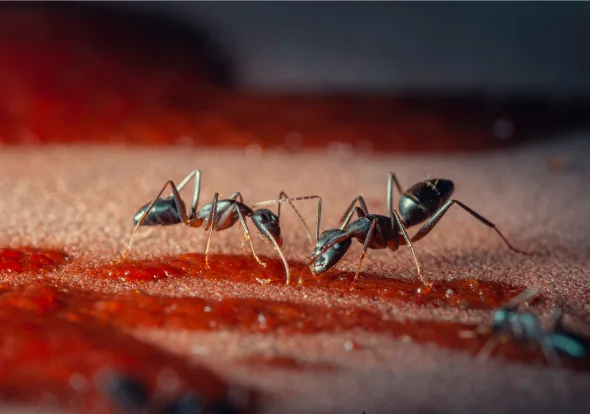 Ants are one of the most persistent pests in homes and businesses throughout Oregon and Washington. The foraging ants you see make up a small amount of the colony —these workers gather food and moisture to sustain the majority of the ants that remain hidden in the nest.
Ants are one of the most persistent pests in homes and businesses throughout Oregon and Washington. The foraging ants you see make up a small amount of the colony —these workers gather food and moisture to sustain the majority of the ants that remain hidden in the nest.
Comprehensive Inspection
Our process begins with a detailed assessment of your property. We identify the ant species, pinpoint infestation hotspots, analyze their food sources, and evaluate environmental factors that may be attracting them. This allows us to develop a targeted and effective treatment plan.
Strategic Treatment Plan
Once we have identified the ant species and contributing conditions, we implement a customized treatment strategy. This may include creating an exterior barrier with precision-applied insecticides, strategically placing bait stations indoors, and, if necessary, injecting treatments into wall voids or other harborage areas to disrupt the colony’s activity.
It is normal to observe increased ant activity following treatment. This is a key part of the process, as the ants must be allowed to collect the bait and transport it back to the nest. Disrupting this activity too soon can reduce the effectiveness of the treatment, as the bait is designed to eliminate the colony at its source.
Ongoing Prevention & Monitoring
Because ant infestations rely on pheromone trails, they can persist and reoccur if not properly managed. Our proactive approach helps eliminate current infestations while reducing the risk of future ones. Through routine inspections and scheduled treatments, we help ensure your home or business remains protected year-round.
Our multi-layered ant control program focuses on both eradication and long-term prevention—providing you with lasting peace of mind.
Professional Ant Control Services
While ants may seem harmless compared to other pests, an infestation can lead to significant issues if not properly managed. At a minimum, they can contaminate food supplies and become a persistent nuisance. In more severe cases, certain species can cause structural damage to your property. Our comprehensive pest control services are designed to provide lasting protection, ensuring your home or business remains ant-free.
- Quarterly & Bi-Monthly Programs
- Target Pests: Ants, spiders and various other crawling insects
-
Service Includes:
- Exterior perimeter inspection and application for crawling insect control
- Removal of accessible wasp nests on the structure of your home
- Sweeping of spider webs followed by an overhead application for spider control
- Interior services as needed
- Quarterly & Bi-Monthly Programs
- Target Pests: Rats, mice, ants, spiders and various other crawling insects.
Service Includes:
- Exterior perimeter inspection and application for crawling insect control
- Removal of accessible wasp nests on the structure of your home
- Sweeping of spider webs followed by an overhead application for spider control
- Service exterior rodent bait stations and inspect for potential entry points
- Interior services as needed
- Quarterly & Bi-Monthly Programs.
- Target Pests: Rats & Mice.
-
Service Includes:
- Exterior perimeter inspection for potential entry points, nesting areas or food sources.
- Seal up identified entry points to prevent the rodents from accesses the interior of your home.
- Service exterior and interior rodent bait stations.
- Interior services as needed.
Identification
Odorous House Ants
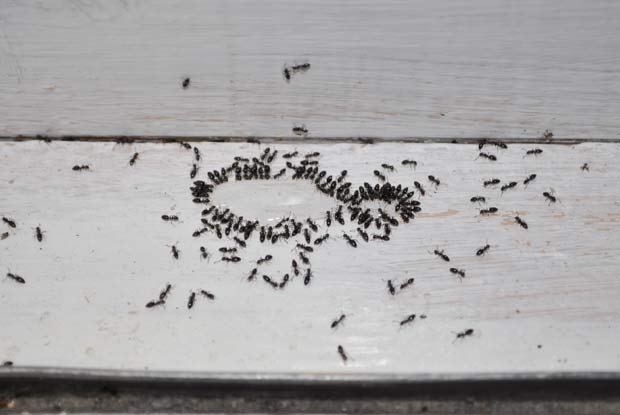 In recent years, odorous house ants have become one of the most prevalent and difficult pests to control in Oregon and Washington. Commonly referred to as sugar ants, they stand apart from other species due to their unique behaviors and biological traits. These ants get their name from the distinct odor they release when crushed—often described as smelling like rotten coconut or ammonia.
In recent years, odorous house ants have become one of the most prevalent and difficult pests to control in Oregon and Washington. Commonly referred to as sugar ants, they stand apart from other species due to their unique behaviors and biological traits. These ants get their name from the distinct odor they release when crushed—often described as smelling like rotten coconut or ammonia.
Rapid Colony Growth & Mobility: Unlike many other ant species, odorous house ants are polygynous, meaning a single colony can contain multiple queens. This allows their populations to expand at an astonishing rate, with some colonies reaching up to 10,000 workers. They are highly adaptable and can establish nests in virtually any environment, from outdoor leaf piles to the insulation within your walls or even inside a kitchen junk drawer. Additionally, they are nomadic, capable of relocating their entire colony in search of better food and shelter sources.
A Unique Defense Mechanism: Budding Odorous house ants possess an advanced survival strategy called budding—a process where the main colony fragments into multiple smaller colonies when threatened. Each sub-colony retains its own queen and workers, allowing them to operate independently and continue to thrive. Unfortunately, many DIY ant control methods trigger this response, making the infestation even worse.
The Risk of DIY Ant Control: Whether at home or at work, many often attempt to manage infestations using household products such as window cleaners, dish soap, essential oils, or over-the-counter insect sprays. However, odorous house ants can detect these chemicals, which frequently causes their colonies to scatter and multiply instead of being eliminated. As a result, the infestation often spreads throughout before professional treatment is sought.
To effectively manage and eliminate odorous house ants, it’s essential to use targeted treatments designed to work with their behaviors rather than against them. Our expert pest control services focus on disrupting their colony structure without triggering budding, ensuring long-term elimination and prevention.
Carpenter Ants: A Serious Structural Threat
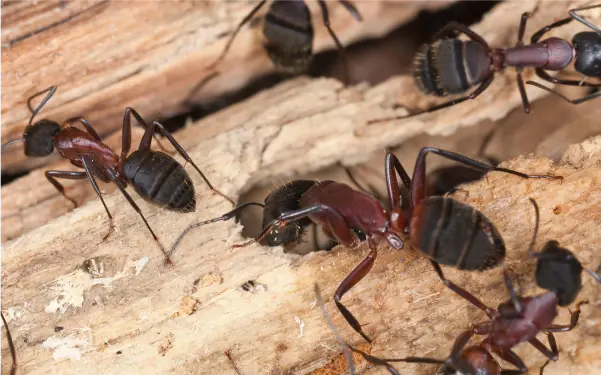 While most ant species are merely a nuisance, carpenter ants pose a significant risk to buildings due to their wood-destroying behavior. As the most prevalent and efficient wood-damaging insect in Oregon and Washington, they can hollow out substantial portions of wood while expanding their nests.
While most ant species are merely a nuisance, carpenter ants pose a significant risk to buildings due to their wood-destroying behavior. As the most prevalent and efficient wood-damaging insect in Oregon and Washington, they can hollow out substantial portions of wood while expanding their nests.
Understanding Carpenter Ant Behavior: Unlike termites, carpenter ants do not consume wood; instead, they tunnel through it to create nesting galleries. In nature, this helps accelerate the decomposition of fallen trees, but inside homes and buildings, it can lead to serious structural damage. One of the most common signs of an infestation is the presence of frass—a sawdust-like material composed of wood shavings, dead nestmates, and other debris. Carpenter ants typically discard frass in designated dumping sites, which can help identify the location of their nest even if the ants themselves remain hidden.
Nest Locations & Spread: The primary, or parent nest, is almost always located outdoors in areas with consistent moisture, such as decaying tree stumps or fallen logs. However, carpenter ants frequently establish satellite colonies inside structures, tunneling into wood beams, wall voids, and other structural elements. These satellite nests can be up to 300 feet away from the parent colony, making detection and elimination challenging without professional intervention.
Because of their ability to remain hidden while causing extensive damage, early detection and targeted treatment are crucial to preventing costly repairs. Our expert carpenter ant control services focus on eliminating both the parent and satellite colonies to protect your home or business from long-term structural damage.
Pavement Ants: A Common Structural Nuisance
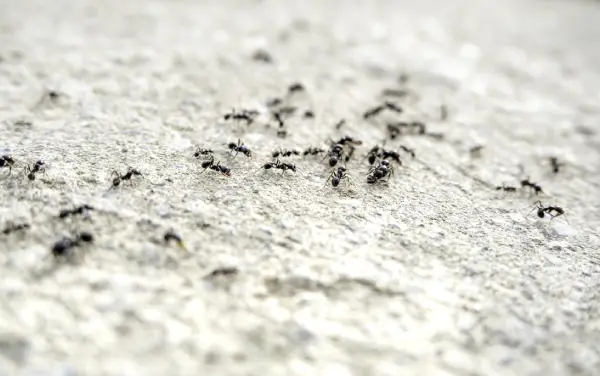
Thatching Ants: Nature’s Roof Builders
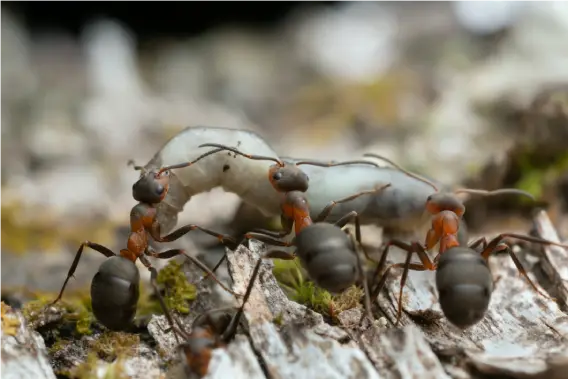 The term “thatching” refers to the craft of layering dry vegetation to create a waterproof barrier—much like what is done when building a thatched roof. Thatching ants exhibit this same behavior, primarily using tree needles from the evergreen species common in our region, such as fir and pine. These industrious ants construct impressive mounds that can reach 3 to 4 feet high, with underground tunnels extending at least as deep as the mound is tall.
The term “thatching” refers to the craft of layering dry vegetation to create a waterproof barrier—much like what is done when building a thatched roof. Thatching ants exhibit this same behavior, primarily using tree needles from the evergreen species common in our region, such as fir and pine. These industrious ants construct impressive mounds that can reach 3 to 4 feet high, with underground tunnels extending at least as deep as the mound is tall.
Colony Structure & Foraging Behavior: Thatching ant colonies feature an extensive network of tunnels and chambers, carefully designed to support brood development. Their foraging ants travel long distances in search of food, creating visible trails throughout yards and natural landscapes. Due to their large colony size and wide foraging range, they can become a persistent nuisance in residential and commercial areas.
Effective Control Measures: The most effective way to manage a thatching ant infestation is by treating the colony at its source—typically at the mound itself. However, when the nest is located on a neighboring property, additional strategies may be required to control their spread. Regardless of nest location, we offer customized treatment solutions to address your specific situation and provide long-term relief from thatching ant activity.
Moisture Ants: Indicators of Wood Decay
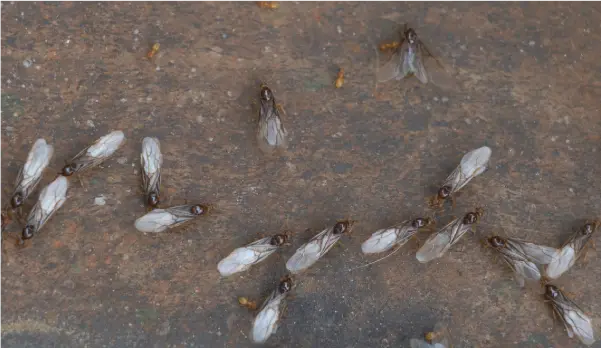
Moisture ants play a significant role in the breakdown of water-damaged wood, often going unnoticed until late summer when reproductive alates swarm into living spaces or during renovations that expose hidden infestations. These colonies, often founded by a single inseminated queen, can grow into the thousands and, under ideal conditions, may persist for over 20 years, posing a long-term structural threat.
Behavior & Structural Impact: Unlike other wood-infesting ants, moisture ants do not consume the wood itself. Instead, they require heavily saturated wood and primarily feed on the fungus that develops from decay. Their tunneling accelerates the decomposition process, creating three-dimensional galleries that resemble a sea sponge, which further retains and distributes moisture, worsening the damage.
Prevention & Control: Preventing moisture ants is straightforward: eliminate the moisture source. Regularly inspect your home or business for leaks, drainage issues, or standing water in crawlspaces. If water damage is detected, prompt repairs are essential. Without a continuous source of high moisture, moisture ant colonies cannot survive, making early intervention the best defense against infestation.
Risks
The Silent Risks of Ant Infestations
Ants are among the most persistent and widespread pests in the Pacific Northwest. Once they invade a space, they leave behind pheromone trails, guiding the rest of the colony to food and shelter. Their dietary preferences shift seasonally, influenced by environmental factors and colony development, making them highly adaptable invaders.
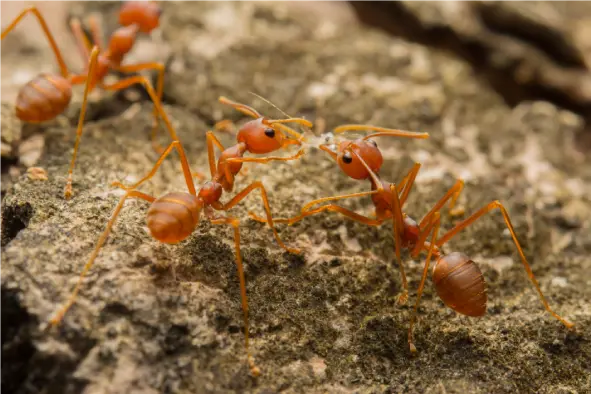
Not All Ants Are Just a Nuisance
- Some ant species are more than just an annoyance—they can cause serious damage to your home or business.
- Odorous House Ants – While they don’t cause structural harm, they contaminate food and emit a foul, rotten coconut-like odor when crushed.
- Carpenter Ants – These wood-destroying pests tunnel through structural beams, causing significant damage to homes and businesses.
- Pavement Ants – Often found along sidewalks and foundations, these ants can invade kitchens and pantries in search of food.
Why Ant Infestations Are Difficult to Control
- Ants are social insects with a complex hierarchy, making infestations particularly challenging to eliminate.
- Colony Structure Makes Eradication Difficult – Worker ants scout, gather food, and maintain the nest, while queens lay eggs continuously, allowing populations to rebound quickly.
- Pheromone Trails Enable Rapid Spread – Ants use chemical signals to communicate, meaning simply killing visible ants won’t solve the problem—hidden colonies remain active.
- Hidden Nests Make Infestations Hard to Detect – Ants often nest within walls, under floors, and in crawl spaces, making DIY control efforts ineffective.
- High Reproductive Rates Ensure Reinfestation – Swarming events allow new colonies to establish quickly, requiring ongoing monitoring and professional intervention to prevent recurrence.
Effective Ant Control Solutions
Our ant control strategies are tailored to the specific species and conditions of your property, ensuring precise and long-lasting results. We utilize a dual-layered exterior treatment combined with strategic interior baiting to not only eliminate existing infestations but also prevent future activity.
Exterior Ant Control
We establish a two-tiered approach around your home or business for maximum protection:
Exterior Perimeter Treatment: Applied along the foundation and extending a couple feet from the foundation using non-repellent, transferable treatments. Ants unknowingly come into contact with these products and carry them back to the colony, spreading the treatment and effectively eliminating the source of the infestation.
Interior Ant Control
Our interior treatment typically consists of targeted bait placements, minimizing disruption and ensuring you do not need to vacate your home or business. We use specially formulated products designed for safe and effective indoor control.
What to Expect After Treatment
While you may notice increased ant activity initially, this is a crucial part of the process, as the ants need time to transport the bait back to the colony. Results become noticeable within a few days, but full effectiveness may take up to two weeks. If activity persists, we will return within the warranty period at no additional cost, utilizing additional treatment methods if necessary.
Since ant infestations often develop over months or even years, complete eradication may require multiple treatments. Additionally, because ants frequently reinfest from neighboring properties and follow established pheromone trails, we often recommend a recurring prevention program to ensure long-term protection and keep your home or business ant-free.
Prevention Tips
Proactive Ant Prevention Tips
Ant infestations can persist year-round due to pheromone trails that guide ants back to food and shelter sources. Even after an initial treatment, properties remain vulnerable to reinfestation. Our team will not only help resolve current ant issues but also provide expert guidance on how to make your property less appealing to pests while identifying any other potential concerns you may not be aware of.
Maintain a Clean Environment
Keeping your home or business clean is one of the most effective ways to deter ants. Pay close attention to the kitchen, wiping down surfaces regularly to eliminate food crumbs, spills, keep pet food in sealed containers and grease that attract foraging ants. Outdoors, clear away debris and clutter near your properties foundation to discourage nesting and ensure our treatments remain effective.
Control Moisture Levels
Ants thrive in damp environments, so addressing moisture issues is crucial. Repair leaks promptly, ensure proper ventilation in high-humidity areas like bathrooms and basements, and remove standing water sources to reduce the likelihood of an infestation.
Trim Vegetation Around Your Home or Business
Overgrown trees, shrubs, and plants that touch your home or place of business provide natural bridges for ants to enter. Regularly trimming back vegetation creates a barrier that makes it more difficult for ants to access your property.
Avoid DIY Treatments
While store-bought ant sprays and traps may seem like a quick fix, they can interfere with professional treatments and cause colonies to scatter rather than be fully eliminated. To ensure the best results, avoid using over-the-counter products and allow our experts to apply the most effective, long-term solutions.
Take Immediate Action
If you notice signs of ant activity, don’t wait—contact us right away. Our specialists will assess the situation, implement targeted treatments, and provide ongoing monitoring to prevent future infestations. For lasting protection, we recommend enrolling in a preventative service plan to keep your home or business ant-free year-round.

